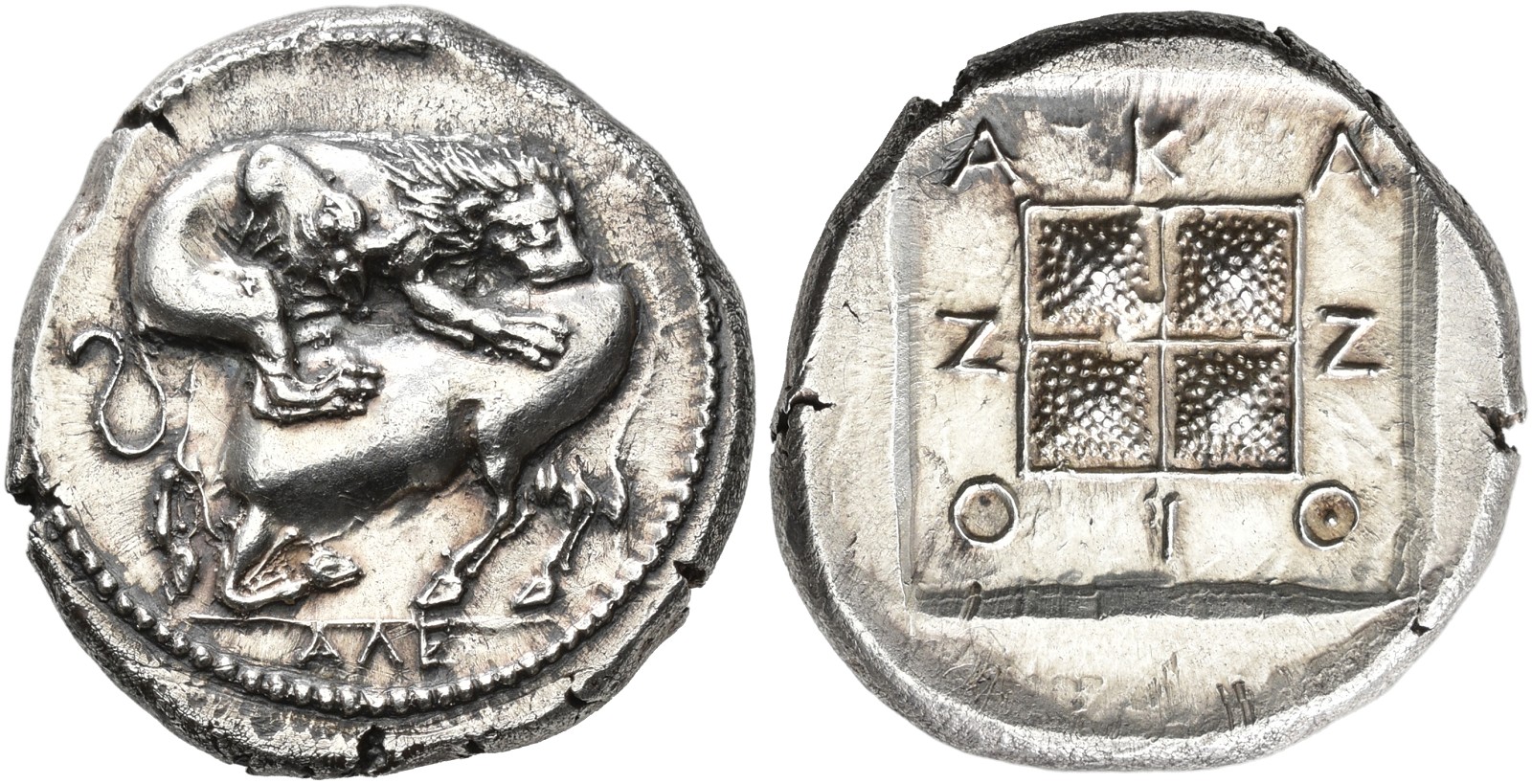AC 148 - Acanthus, silver, tetradrachms (424-380 BCE) Desneux
From SILVER
424 BCE - 380 BCE Silver 21,414 kg
Description
| ObverseInscription or printing placed on the obverse.: | Lion r., attacking bull kneeling l. |
| ReverseInscription or printing placed on the reverse.: | AKANΘION (Greek).AKA / N / ΘIO / N around small four-part square with raised, granulated compartments, whole in flat incuse square |
Mint and issuing power
| MintIdentifies the place of manufacture or issue of a numismatic object.: | Acanthus | Ancient regionAncient region.: | Macedon | Modern countryModern country: Greece | AuthorityIdentifies the issuing power. The authority can be "pretended" when the name or the portrait of X is on the coin but he/she was not the issuing power. It can also be "uncertain" when there is no mention of X on the coin but he/she was the issuing power according to the historical sources: |
Chronology
| FromIdentifies the initial date in a range assigned in a numismatic context. | 424 BCE | toIdentifies the final date in a range assigned in a numismatic context.. | 380 BCE | PeriodTime period of the numismatic object.: Classical 480-323 BC |
Physical description
| MetalThe physical material (usually metal) from which an object is made.: | Silver |
Median weightMedian of the weights of numismatic objects (in grams). in grams | 14.20 | DenominationTerm indicating the value of a numismatic object. Examples: tetradrachm, chalkous, denarius.: | tetradrachm |
StandardStandard.: |
Image

AC148 Acanthus.jpg [1]
References
| Die study referencePublication of the study: | Desneux 19491Desneux 1949, n° 116-63. | ||
| Coin series referenceReference to coin series study: | Sear I2Sear I, n° 1367-1368, RQEMAC3RQEMAC, n° 148 | ||
| Coin series web referenceCoin series web references: | |||
Obverse dies distribution
| FrequencyFrequency of specimen in distribution. ᵖ | Number of obversesNumber of obverse dies. ᵖ (o) | % (o) | Number of coinsNumber of coins. (n) | % (n) | Die nameName(s) of the die(s). |
| 1 | 21 | 53.85 | 21 | 31.34 | 112, 113, 115, 117, 118, 119, 120, 121, 123, 124, 125, 131, 134, 135, 136, 138, 142, 146, 147, 148, 149 |
| 2 | 11 | 28.21 | 22 | 32.84 | 114, 122, 126, 128, 130, 132, 133, 137, 143, 144, 145 |
| 3 | 4 | 10.26 | 12 | 17.91 | 116, 129, 139, 141 |
| 4 | 3 | 7.69 | 12 | 17.91 | 127, 140, 150 |
| Total | 39 of 39 | 100.01 | 67 of 67 | 100 |
Reverse dies distribution
no distribution is available
Quantification
| Number of obversesNumber of obverse dies. ᵖ (o) | 39 | Number of singletons (o1)The number of singleton coins. ᵖ | 21 |
| Number of reverse diesNumber of reverse dies. (r) | 44 | Number of coinsNumber of coins. (n) | 67 |
| Coins per obverse dieNumber of coins per obverse die. (n/o) | 1.72 | Coins per reverse dieNumber of coins per reverse die. (n/r) | 1.52 |
| Reverse per obverse ratioRatio of obverse dies divided by reverse dies. (r/o) | 1.13 | Percentage of singletons (o1)number of coins (n) divided by the number of singletons (o1) ᵖ | 53.85 % |
| Original number of dies (O) (Carter 1983 formula)The estimation of the number of coins according to Carter 1983 ᵖ | 75.4 | Coins struck if 20,000 as average productivity per dieCoins made if the average productivity for obverses (according to Carter) is 20,000. ᵖ | 1,508,000 |
| Original number of dies (O) (Esty 2011 formula)The estimation of the number of coins according to the singleton formula in Esty 2011 ᵖ (O) | 93.32 | Survival rate if 20,000 as average productivity per dieSurvival rate if average productivity is 20,000. ᵖ | 0.00004 |
| Coverage (o = % of O) (Esty 1984 formula)Esty 1984 - coverage (% of O) ᵖ (o = % of O) | 68.66% | Die productivity if survival rate 1/2,000Average productivity if survival rate is 1/2,000. ᵖ | 1,777.19 |
| Weight of silver (in kg) if 20,000 coins per die (O = Carter formula)Carter 1983 * Median weight * 20000 (*10 if gold or electrum) ᵖ | 21,414 kg <br /> 21,414 kg | Die productivity if survival rate 1/5,000Average productivity if survival rate is 1/5,000. ᵖ | 4,442.97 |
Remarks
References
- ^ Desneux, Jules (1949), "Les tétradrachmes d’Akanthos", Revue Belge de Numismatique, 95, p. 5-122, pl. 1-38.
- ^ Sear, David R. (1978), Greek coins and their values. Vol. I, Europe, London, xl, 316 p.
- ^ Callataÿ, François de (2003), Recueil quantitatif des émissions monétaires archaïques et classiques, Numismatique Romaine, Wetteren, VII + 267 p.